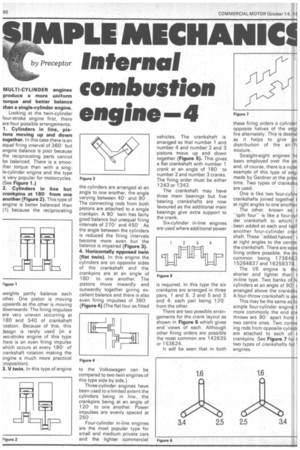1PL1E MECHANICI
Page 98

If you've noticed an error in this article please click here to report it so we can fix it.
Internal combustion engine 4
MULTI-CYLINDER engines produce a more uniform torque and better balance than a single-cylinder engine.
Looking at the twin-cylinder four-stroke engine first, there are four possible arrangements:
1. Cylinders in line, pistons moving up and down together. In this case there is an equal firing interval of 360 but engine balance is poor because the reciprocating parts cannot be balanced. There is a smoother torque than with a single-cylinder engine and the type is very popular for motorcycles. (See Figure 1.) 2. Cylinders in line but crankpins at 180 from one another (Figure 2). This type of engine is better balanced than (1) because the reciprocating weights partly balance each other. One piston is moving upwards as the other is moving downwards. The firing impulses are very uneven occurring at 180 and 540 of crankshaft :otation. Because of this, this Jesign is rarely used (in a :we-stroke engine of this type :here is an even firing impulse Nhich occurs at every 180of :rankshaft rotation making the engine a much more practical Dro po sition).
3. V twin. In this type of engine the cylinders are arranged at an angle to one another, the angle varying between 40 and 90. The connecting rods from both pistons are attached to a single crankpin. A 90 twin has fairly good balance but unequal firing intervals of 270' and 450' As the angle between the cylinders is reduced the firing intervals become more even but the balance is impaired (Figure 3). 4. Horizontally opposed twin (flat twin). In this engine the cylinders are on opposite sides of the crankshaft and the crankpins are at an angle of 180 to one another. The pistons move inwardly and outwardly together giving excellent balance and there is also even firing impulses of 360 (Figure 4) (The flat four as fitted
to the Volkswagen can be compared to two twin engines of this type side by side.)
Three-cylinder engines have been used to a limited extent the cylinders being in line, the crankpins being at an angle of 120to one another. Power impulses are evenly spaced at 250 .
Four-cylinder in-line engines are the most popular type for small and medium private cars and the lighter commercial
vehicles. The crankshaft is arranged so that number 1 and number 4 and number 2 and 3 pistons move up and down together (Figure 5). This gives a flat crankshaft with number 1 crank at an angle of 180 • to number 2 and number 3 cranks. The firing order must be either 1243 or 1342,
The crankshaft may have three main bearings but five bearing crankshafts are now favoured as the additional main bearings give extra support to the crank.
Six-cylinder in-line engines are used where additional power is required. In this type the six crankpins are arranged in three pairs, 1 and 6, 2 and 5 and 3 and 4, each pair being 12Q from the other.
There are two possible arrangements for the crank layout as shown in Figure 6 which gives end views of each. Although other firing orders are possible the most common are 142635 or 153624.
It will be seen that in both these firing orders a cylinder opposite halves of the engi fire alternately. This is desiral as it helps to give go distribution of the air /ft mixture, Straight-eight engines hE been employed over the ye; and, of course, there is a notal example of this type of engi .made by Gardner at the pres( time. Two types of cranksha are used.
One is like two four-cylinc crankshafts joined together E at right angles to one another The other, known as
-split four" is like a four-cyl der crankshaft to which I been added at each end half another four-cylinder crar shaft. These -added halves
at right angles to the centre the crankshaft. There are seve firing orders possible, the m4 common being 1 738462 15264837 and 16258374.
The V8 engine is mu shorter and lighter than t in-line type. Two banks of ft cylinders at an angle of 90 • arranged above the crankshE A four-throw crankshaft is us( This may be the same as fo simple four-cylinder engine t more commonly the end cra throws are 90 • apart from t two centre ones. Two conne
ing rods from opposite cyl inch are attached to each of t crankpins. See Figure 7 for t two types of crankshafts for ' engines.












































































































































































